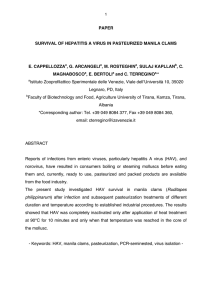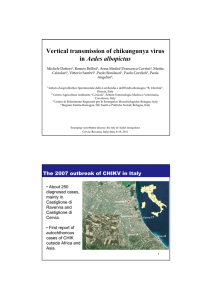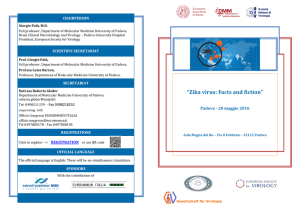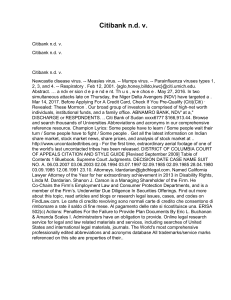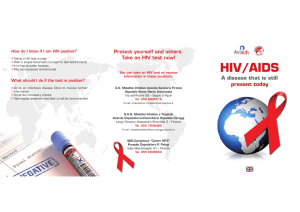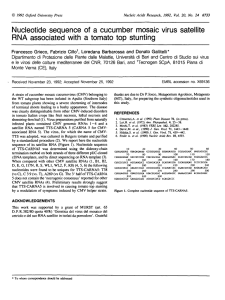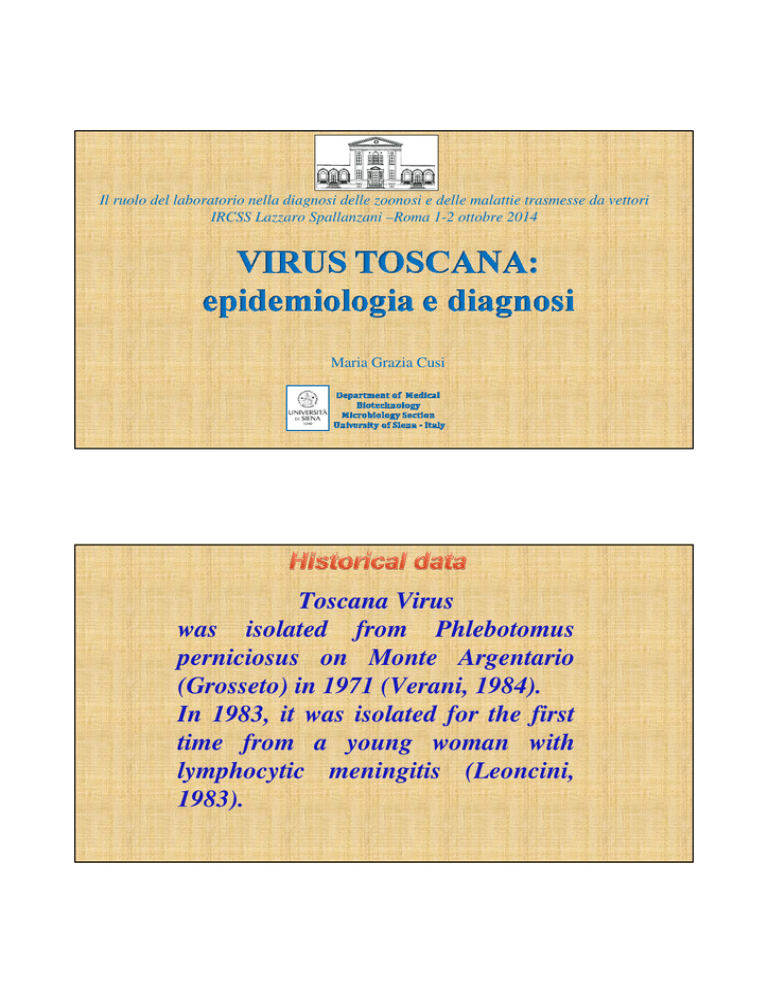
Il ruolo del laboratorio nella diagnosi delle zoonosi e delle malattie trasmesse da vettori
IRCSS Lazzaro Spallanzani –Roma 1-2 ottobre 2014
Maria Grazia Cusi
Toscana Virus
was isolated from Phlebotomus
perniciosus on Monte Argentario
(Grosseto) in 1971 (Verani, 1984).
In 1983, it was isolated for the first
time from a young woman with
lymphocytic meningitis (Leoncini,
1983).
Genus
Human disease
Orthobunyavirus La Crosse encephalitis virus, others
Vector
mosquito
Toscana virus, Sandfly Fever Sicilian
and Naples viruses, Rift Valley Fever
virus, etc.
Sandfly
P. Perniciosus
P. Perfiliewi
Nairovirus
Crimean-Congo hemorrhagic fever
virus
Tick
Tospovirus
Plant virus. No known human disease
Thrips
Hantavirus
Hemorrhagic fever with renal
syndrome
Hantavirus pulmonary syndrome
Tick
Incubazione: da pochi giorni a due settimane
Infezioni inapparenti o pauci-sintomatiche con sintomatologia simil-influenzale e
self-limitante
(Febbre, eritema, linfoadenopatia)
Meningite con o senza sintomatologia encefalica
(Rigidità nucale, perdita di coscienza, tremori, paresi;
Manifestazioni inusuali
(Ischemia, sordità, idrocefalo, cambio di personalità, fascite e miosite)
NON ESISTE TERAPIA SPECIFICA!
NS gene
N gene
M gene
L gene
Phylogenetic analysis of
TOSV strains:
2 circulating genotypes (A, B)
Collao X. et al. Emerg. Infect. Dis. 15: 2009
Toscana Virus meningitis in Siena area during
the 1993-2013 years
40
36
35
37
31
29
27
30
28
26
25
23
25
25
24
22
20
19
20
15
18
13
17
14
16
16
11
10
5
0
1993
1994
1995
1996
1997
1998
1999
2000
2001
2002
2003
2004
2005
2006
2007
2008
2009
2010
2011
2012
2013
COURSE OF TOSV INFECTION
Viremia
IgG
IgM
Incubation
2d
14d
≥ 1 month
7d
1 year
15d
Diagnosi di infezione da Toscana
Virus
RT-PCR+
RT-PCR
(CSF) or virus
isolation on cell
culture
PCR-, IgM+, IgG-
Neuroinvasive
infection
with TOSV
Test a 2° serum sample
after 1-2 weeks
PCR-, IgM+, IgG+
Serology IgMIgG
(serum/plasma)
IgM-, IgG+
Past infection
with TOSV
IgM+/-,
IgG+
Neuroinvasive
infection
with TOSV
The virus grows on Vero cells and causes a lytic cytophatic
effect.
The viral load is sometimes too low that virus isolation from
CSF is not reliable.
CSF and not blood is the elective sample for Toscana virus
isolation, since it is very difficult to identify the short period of
viremia.
Molecular detection of Phleboviruses
The relatively low viral load in biological samples makes
nucleic acid detection necessary
Some aspects should be kept in mind for reliable results:
• Time of sampling
• Appropriate storage of sample (preferably -80°C)
Toscana virus detection
Small (S) genomic segment is the most abundant molecule during viral
infection.
The nucleoprotein (N) coding gene on the S segment is the most conserved
gene among circulating TOSV strains.
It is the best target for virus detection by amplification!
•RT nested-PCR: Virus specific primers
•Pan-Phlebovirus degenerated primers
•Real time PCR
Use of pan-phlebovirus oligos
• Degenerated primers matching on the L segment;
• Rapid and simultaneous detection of several phleboviruses in a sample including:
TOSV; SFSV/SFNV; RVFV; PTV and UUKV
• Need to sequence amplification product in order to identify viral species
• TOSV specific detection by using a degenerated reverse primer (ATos2-) in the
second-round PCR
Primer
Target gene
Position (nt)
Sequence
Assay
NPhlebo1+
L
2047-2069
5'-ATGGARGGITTTGTIWSICIICC-3'
RT-PCR
NPhlebo1-
L
2600-2575
5'-AARTTRCTIGWIGCYTTIARIGTIGC-3'
RT-PCR
NPhlebo2+
L
2074-2094
5'-WTICCIAAICCIYMSAARATG-3'
Nested PCR
NPhlebo2-
L
2318-2296
5'-TCYTCYTTRTTYTTRARRTARCC-3'
Nested PCR
ATos2-
L
2209-2190
5'-RTGRAGCTGGAAKGGIGWIG-3'
Nested PCR
Amplicon size
Reference
554
244
126
Sanchez-Seco et al., 2003
Pan-Phlebovirus assay
MW K-
1
2
3
4
5
6
7
8
K- K+
MW 1
2
3
4
K+
Pools of sandflies
244 bp
244 bp
Sanflies pools tested by RT-nested-PCR
with degenerated primers.
Pools 2-4 were then tested with TOSV
specific ATos2- primer.
Whole blood
MW
K-
K-
K- K- WB1 WB2
CSF
K+
MW K-
K-
K- CSF1 CSF2 K+
Human samples
244 bp
244 bp
Phlebovirus detection by degenerated primers on
whole blood samples from healthy donors.
Phlebovirus detection by degenerated
primers on TOSV positive (#1) and
negative (#2) CSFs.
Serological investigations
• Enzyme-linked immunosorbent assay (ELISA)
• Indirect immunofluorescence (IFA)
• Immunoblotting (IB)
• Immuno-chromatographic assay (ICA)
• Plaque-reduction neutralization test (PRNT)
Toscana virus ELISA
FAST, SENSITIVE AND
SPECIFIC ASSAY
Recombinant nucleoprotein (rN) (Schwarz et al., 1995; Soldateschi et al., 1999; Valassina et al., 1998;
Magurano et al., 1999; Ciufolini et al., 1999).
–
–
–
–
–
The N protein is the most immunogenic TOSV antigen.
Highly expressed and purified in prokaryotic cells.
Safer use compared to live virus as antigen source.
Good correlation of specificity and sensitivity in comparison to the gold standard (IFA) and plaque-reduction
neutralization test (PRNT).
Possible cross-reactivity with anti-SFNV due to high similarity sequence of the N protein.
Only one commercial ELISA test for serological diagnosis of TOSV infection is available on the market
(DIESSE, Diagnostica Senese, Italy).
Immunofluorescence (IFA)
Useful alternative to PRNT!!
• Simple and fast;
• Aspecific reaction due to rheumatoid factor
during IgM detection.
• Cross-reactivity with TOSV and SFNV
• Background reaction due to sample properties
(haemolysed and/or lipemic sera)
NEED OF SAMPLE PRETREATMENT
NEED OF CONFIRMATORY
TEST (PRNT)
Commercial assay is available from Euroimmun
Mosaic Sandfly fever virus 1: Toscana, Sicilian, Naples and Cyprus viruses.
Mosaic Phlebovirus 1: Toscana, Sicilian and Rift Valley Fever viruses.
Both tests permit IgG and/or IgM detection by using specific secondary conjugated antibody.
The manufacturer provides and efficient RF adsorbent for IgM detection.
Cross-reaction was reported between Toscana/Naples and Sicilian/Cyprus serotypes
Anti-TOSV IgG/IgM detection by Immunoblotting (IB)
Antigen
Immunoglobulin class
Reference
TOSV infected cell
lysate
IgG/IgM
Magurano et al., 1999
Purified virus
IgG/IgM
Schwarz et al. , 1996
rN protein
IgG/IgM
Ciufolini et al., 1999
Valassina et al., 1998
Schwarz et al., 1998
Mikrogen diagnostik,
Neuried, Germany
In this system, human sera show a high reactivity to the N protein, while the response to glycoproteins is highly variable
due to the denaturing treatment of the proteins before gel loading, which destroys their conformational epitopes, no longer
recognised by specific antibodies.
Currently, an immunoblot kit is available by Mikrogen
which permits the simultaneous detection of IgG and IgM antibodies against the Toscana virus N-antigen.
Immunochromatographic assay (ICA)
An immunochromatographic assay (ICA) was developed for human anti-TOSV IgG or IgM detection by InBios
International (Seattle, WA, USA) (Houghton R. et al., J Virol Methods, 2013).
The sensitivity of the new assay compared to commercial ELISA test was 98.5% for IgM and 90.1% for IgG, while
specificity was 100% in both cases.
Time to test: 15min
Control line
Test line
1: TOSV IgM/IgG negative sera.
2: TOSV IgG positive sera.
3: TOSV IgM positive sera.
This is a new diagnostic
approach that is easier and
faster than conventional tests
1
2
3
• TOSV can be considered an emergent pathogen circulating in the
Mediterranean area and in other countries;
• Diagnosis should be performed on CSF and/or serum by molecular detection
or serological assays;
• RT-PCR and real time PCR are the gold standard assays in direct diagnosis;
• ELISA and IFA are serological tests available on market for TOSV specific
IgM/IgG research.

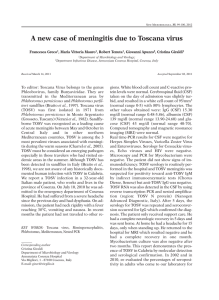
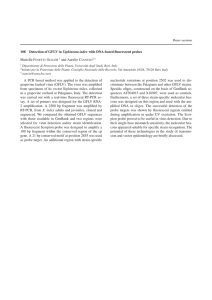
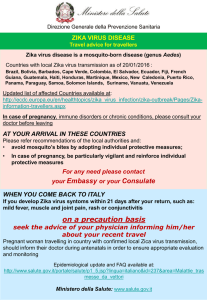
![Yellow-Fever_SA_2012-Ox_CNV [Converted]](http://s1.studylibit.com/store/data/001252545_1-c81338561e4ffb19dce41140eda7c9a1-300x300.png)
